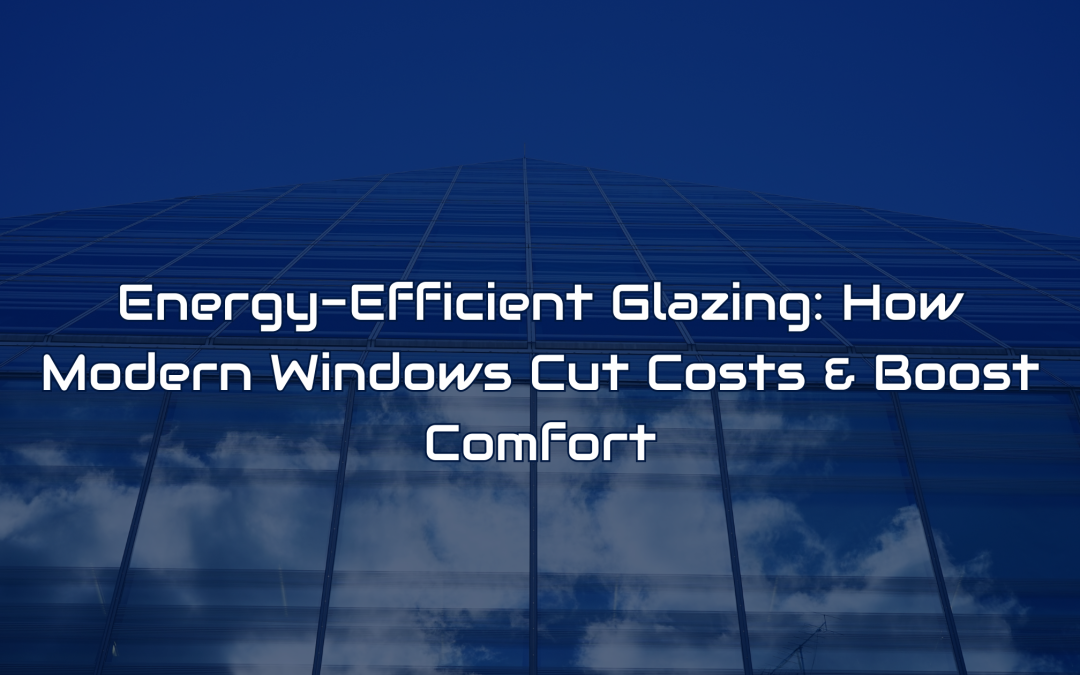Reducing energy consumption while maintaining a comfortable and efficient workspace is a priority for many businesses. One of the most effective ways to achieve this is through energy-efficient glazing. More than just an aesthetic enhancement, modern glazing solutions are designed to improve insulation, regulate internal temperatures, and significantly lower energy costs. At Visual Concept, we specialise in bespoke glazing systems tailored for commercial and residential properties, helping businesses enhance sustainability, reduce operational expenses, and create a more productive environment.
Why Energy-Efficient Glazing Matters
Windows are a key part of any building’s energy performance. Poorly insulated windows allow heat to escape in winter and let excessive heat in during summer, leading to higher energy bills and an uncomfortable indoor environment. Energy-efficient glazing solves this problem by reducing heat loss, improving insulation, and keeping spaces at a more stable temperature year-round. This means lower energy consumption, reduced reliance on heating and cooling systems, and a more sustainable approach to modern living.
Beyond energy savings, high-performance glazing also enhances indoor comfort. No more cold drafts in winter or stifling heat in summer. Instead, well-insulated windows help maintain a balanced and pleasant indoor climate, making homes and workplaces more enjoyable places to be.
How Does Energy-Efficient Glazing Work?
Advancements in glazing technology mean that modern glazing structures can now offer superior insulation and efficiency. Some of the key features of energy-efficient glazing include:
- Double and Triple Glazing: Multiple layers of glass with insulating gas in between create a barrier against heat loss and external temperatures.
- Low-E Coatings: A thin, invisible layer that reflects heat back into a room, improving insulation without blocking natural light.
- Gas-Filled Units: Instead of standard air, argon or krypton gas is used between glass panes to slow heat transfer and enhance energy performance.
- Thermally Broken Frames: High-quality materials, such as aluminium with built-in insulation, prevent heat from escaping through window frames.
- Solar Control Glass: Special coatings can reduce glare and overheating in warmer climates while maintaining energy efficiency.
Choosing the Right Energy-Efficient Windows
Selecting the best energy-efficient glazing depends on several factors, including climate, building type, and orientation. Commercial properties in colder regions can benefit from triple glazing for enhanced insulation, while those in warmer climates may opt for solar control glazing to minimise overheating and reduce cooling costs. While residential homes often prioritise noise reduction, businesses typically focus on maximising thermal efficiency to lower energy consumption and improve operational savings.
When choosing new windows, it’s also important to consider energy ratings. High-performance glazing systems come with energy efficiency ratings that indicate how well they prevent heat loss and regulate indoor temperatures. Investing in high-rated windows ensures long-term savings and a reduced carbon footprint.
Real-World Impact: Cattle Market Redevelopment
A great example of energy-efficient glazing in action is the redevelopment of the former Cattle Market site. Completed in October 2022, this large-scale project involved the creation of 360 managed apartments spread across four blocks. Visual Concept was responsible for the design, manufacture, and installation of all glazing facades, including entrance doors.
To enhance energy efficiency, we integrated high-performance double glazing with thermally broken aluminium frames. These features significantly improved insulation, reducing the need for excessive heating and cooling. By maintaining stable indoor temperatures, the glazing also contributed to lower energy consumption for residents, making the apartments more sustainable and cost-effective in the long run.
Additionally, the project revitalised an area that had been derelict since 2008, demonstrating how modern glazing can contribute to both urban regeneration and sustainability. The improved energy performance also aligned with current building regulations and sustainability targets, reinforcing the value of energy-efficient glazing in large-scale developments.
The Future of Energy-Efficient Glazing
With stricter energy regulations and a growing emphasis on sustainability, energy-efficient glazing is becoming a key feature of modern construction. As energy prices continue to rise, more property owners are recognising the long-term benefits of investing in high-performance windows. Not only does this lead to financial savings, but it also reduces environmental impact by lowering carbon emissions and improving overall energy efficiency.
Innovations in glazing technology continue to advance, with the introduction of smart glass solutions that can dynamically adjust tint levels to control light and temperature. These developments mean that energy-efficient glazing will play an even more significant role in sustainable building practices in the years to come.
Transform Your Space with Energy-Efficient Glazing
At Visual Concept, we offer bespoke energy-efficient glazing solutions tailored to your specific needs. Whether you’re looking to enhance a residential home or a commercial property, our expert team can guide you through the best options for improving insulation, reducing energy bills, and creating a more sustainable space.
By choosing the right glazing system, you’re not only improving comfort and efficiency but also adding value to your property. High-quality energy-efficient glazing enhances curb appeal, meets modern building standards, and ensures long-term cost savings on energy bills.
If you’re ready to upgrade to high-performance windows that offer both style and efficiency, contact us today to learn more about our energy-efficient glazing solutions. Start saving on energy costs while making your property more comfortable and environmentally friendly.
